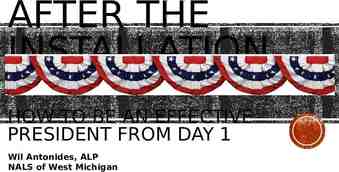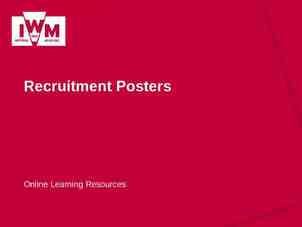1 Introduction 1 to Logistics and Supply Chain
59 Slides170.58 KB
1 Introduction 1 to Logistics and Supply Chain
PETER DRUCKERS stated that: Logistics is one of the last frontiers of opportunity for organizations wishing to improve their corporate efficiency.
1 1 Logistics Management Logistics management is the process of planning, implementing and controlling the efficient, cost-effective forward and reverse flow of raw materials, in-process inventory, finished goods, services, and related information from point of origin to point of consumption for the purpose of conforming to customer requirements. Council of Logistics Management
Logistics activities Plant Customer and warehouse service site Demand selectionforecasting Procurement Distribution Packaging communications Reverse Inventory logistics control Traffic Material and handling transportation Warehousing Order processing and storage Parts and service support
Logistics Is Relevant to All Types of Organizations The definition of logistics includes the flow of materials and services in both the manufacturing and service sector. The service sector includes entities such as the government, hospitals, banks, retailers and wholesalers.
Definition of Logistics Management Logistics has been called by many names including the following: – – – – – – – Materials management Physical distribution Business logistics Channel management Distribution Industrial logistics Logistical management
System Approach/Integration Logistics is, in itself, a system; it is a network of related activities with the purpose of managing the orderly flow of goods, information and service with the logistics channel. The systems approach simply states that all functions or activities need to be understood in terms of how they affect, and are affected by, other elements and activities with which they interact.
System must be viewed as a whole Logistics and Supply Chain Management Approach
Systems Approach The sum of a series of activities is greater than its individual parts. Trade-off analysis-system should be viewed as a whole. High inventory- High customer service High storage costs High obsolescence risks
The Five Rights of Logistics Right Items, needed for consumption or production, Right Place Right Time Right Condition Right Cost,
Logistics Adds Value by Creating Utility FORM UTILITY is the process of creating the good and service, or putting it in the proper form for the customer to use. (from raw materials to finished goods) POSSESSION UTILITY is the value added to a product or service because the customer is able to take actual possession. (by credit a arrangements, loans.) TIME UTILITY is the value added by having an item when it is needed. PLACE UTILITY means having the item or service available where it is needed.
Logistics Supports Marketing According to Kotler and Armstrong; – marketing management - determining the needs and wants of target markets and delivering the desired satisfactions more effectively and efficiently than competitors – Impact of marketing concept ----customer orientation
14 Marketing / Logistics Management Concept Customer satisfaction Suppliers Intermediate customers Final customers Integrated effort Company profit Product Price Promotion Place (distribution) Maximize long-term profitability Lowest total costs given an acceptable level of customer service
Marketing-Logistics Concepts Time and place utility –customer service level –customer satisfaction Customer service is an output of the logistics system
Competitive Advantage The source of competitive advantage is found ; – In the ability of the organization to differentiate itself, in the eyes of the customer, from its competitors, – By operating at a lower cost and hence at greater profit. Christopher s.5
It is only in the recent past that business organizations have come to recognize the vital impact that logistics management can have in the achievement of competitive advantage. Martin Christopher
12 Components of Logistics Management Management actions Inputs into logistics Natural resources (land, facilities, and equipment) Human resources Planning Implementation Control Outputs of logistics Competitive advantage Logistics management Suppliers Raw In-process Finished materials inventory goods Customers Time and place utility Financial resources Efficient movement to customer Information resources Proprietary asset Logistics activities Customer service Plant and warehouse site Demand forecasting selection Distribution Procurement Packaging communications Inventory control Reverse logistics Material handling Traffic and transportation Order processing Warehousing and storage Parts and service support
The Outputs of the Logistics System The outputs of the logistics system are competitive advantage, time and place utility, efficient movement to the customer, and providing a logistics service mix such that logistics becomes a proprietary asset of the organization.
SCM (CSCMP Definition) Supply Chain Management encompasses the planning and management of all activities involved in sourcing and procurement, conversion, and all logistics activities. Importantly, it also includes coordination and collaboration with channel partners, which can be suppliers, intermediaries, third-party service providers, and customers. In essence, Supply Chain Management integrates supply and demand management within and across companies.
Competition Today the real competition is not company against company but rather supply chain against supply chain. Christopher s. 16,38
1 3 Factors Impacting the Development of Logistics Military logistics developments Transportation deregulation Competitive pressures Information technology Channel power Profit leverage
1.Military Logistics Throughout the history ; wars have been won and lost through logistics strengths and capabilities or the lack of them.
1.Military Logistics Following the World War II, logistics began to receive increased recognition and emphasis. In the Persian Gulf War in 1990-1991, the ability to efficiently and effectively distribute and store supplies and personnel were key factors in the success of the US Armed Force.
2.Deregulation Deregulation of the transportation industry in the late 1970s and early 1980s gave organizations many more options and increased the competition within and between transportation modes. Carriers become more creative, flexible, customer-oriented, and comparative in order to succeed. They can focus on negotiation of rates, terms, and services, with their overall attention directed toward getting the best transportation buy.
3. Competitive Pressures Globalization and competition With rising interest rates and increasing energy costs during the 1970s, logistics received more attention as a cost driver-emphasis on cost control WHY? Local firms versus overseas competitors Increased offshore buying and selling activities, more complex and more costly global supply chains
4.Information Technology Information technology gave organizations the ability to better monitor transactions intensive activities such as ordering, movement of goods. Computerized quantitative models for controlling and optimization MRP,MRP II,DRP,DRP II,JIT link material management from order processing to inventory management, forecasting and production.
5.Channel Power Shifting channel power from manufacturers to retailers, wholesalers, and distributors has also had a profound impact on logistics. Lower brand loyalty decreases a manufacturer’s power-increases retailer’s power
6. Profit Leverage 1 saved in logistics costs has a much greater impact on the organization’s profitability than a 1 increase in sales. There are costs associated with sales ( cost of goods sold ) ] 1 increase in sales does not result in 1 dolar increase in profit
Key Logistics Activities 1 6 Customer service Demand forecasting Inventory management Logistics communications Material handling Order processing Packaging Parts & service support Plant & warehouse site selection Procurement Reverse logistics Traffic & transportation Warehousing & storage
CUSTOMER SERVICE Good customer service supports customer satisfaction. Customer service is the output of the logistics system. It involves getting the right product, to the right customer at the right place, in the right condition, at the right time and at the lowest total cost possible. The key trade off of customer service: cost of lost sales Dissatisfied customer tells to average of nine others
DEMAND FORECASTING There are many types of demand forecasting such as; – marketing forecasts customer demand based on promotions, pricing, competition and etc. or – manufacturing forecasts production requirements based on marketing sales demand forecasts and current inventory levels. Logistics usually becomes involved in forecasting in terms of how much should be ordered from its suppliers and how much of finished product should be transported or held in each market that the organization serves.
INVENTORY MANAGEMENT Inventory management involves ; trading off the level of inventory held to achieve high customer service levels with the cost of holding inventory, including capital tied up in inventory, variable storage costs and obsolescence.
LOGISTICS COMMUNICATIONS Communications are becoming increasingly automated, complex and rapid. Computerized systems Wal-Mart advance communication ( supplier link-real time demand data-on time replenishment)
MATERIALS HANDLING Materials handling is a broad area that encompasses virtually all aspects of all movements of raw materials, work in process, or finished goods within a plant or warehouse. A primary objective of materials management is to eliminate handling wherever possible-min. travel distance, bottlenecks, inventory levels and loss.
ORDER PROCESSING Order processing entails the systems getting orders from customers, checking on the status of orders communicating to customers about them, filling the order making it available to the customer. Advanced order-processing methods ( EDIelectronic data interchange, EFT-electronic funds transfer, barcoding costs
PACKAGING For protection and storage from a logistical perspective. Important for protection during storage and transportaion Important to be designed for the warehouse configuration and materials handling equipment
PARTS AND SERVICE SUPPORT Logistics is responsible for providing after-sale service support. This may include: – delivery of repair parts to dealers, – stocking adequate spares, – responding quickly to demand for repairs.
PLANT AND WAREHOUSE SITE SELECTION Determining the location of the company’s plants and warehouses is a strategic decision affects the costs of transporting raw materials inbound and finished goods outbound, but also customer service levels and speed of response.
PROCUREMENT Procurement is the purchase of materials and service from outside organizations to support the firm’s operations from production to marketing, sales, and logistics. Supplier selection, negotiation of price, supplier quality assessment
REVERSE LOGISTICS Reverse flow of goods, services and related information because of recycling, reusing and disposal activities. Returns may take place because of a problem with the performance of the item or simply because of the customer changed his or her mind. Return goods handling is complex and costly. The cost of moving a product backward nearly as much as nine times as high as moving the same product forward.
TRAFFIC AND TRANSPORTATION This is the key logistics activity actually provide for the movement of materials and goods from point of origin to point of consumption and (disposal as well) Selection of mode, routing the shipment, assuring of compliance with regulations in the region of the country where shipment is occuring, selection of the carrier Largest logistics cost
WAREHOUSING AND STORAGE Warehousing supports time and place utility by allowing an item to be produced and helps for later consumption. Warehouse layout, design,ownership, automation
Logistics activity is literally thousands of years old, dating back to the earliest forms of organized trade. As an area of study however, it first began to gain attention in the early 1900s -in the distribution of farm products, -as a way to support the organization’s business strategy, -and as a way of providing time and place utility.
Development of Logistics 6 Eras Era 1: Farm to market ( early 1900s) ( 1916-1940) Major influence- agricultural economies distribution of farm products transportation Era 2: Segmented functions (1940-1960) Major influence-military with World War II independent functions-institutional approach, inbound outbound transportation, wholesaling, retailing, physical distribution
Era 3: Integrated functions ( early 1960s- early 1970s) Major influence- industrial economies Linking them together Total cost approach Systems approach Integration of logistics Era 4: Customer focus (early 1970s-mid 1980) Major influence: management science Customer service Inventory carrying Productivity Link-node OR influence
Era 5: Logistics as a differentiator ( mid 1980s-present) Major influence-IT, management strategy globalization reverse logistics environment integrated supply chain management Era 6: Behavioral and boundary spanning (future) Major influence: marketing, social sciences behavioral aspects of interfirm relations theory development customer perceptions of logistics systems
TOTAL COST CONCEPT “The total cost concept” is the key to effectively managing logistics processes. The goal of the organization should be to reduce the total cost of logistics activities, rather than focusing on each activity in isolation.
1 7 MAJOR LOGISTICS COST CATEGORIES Customer service levels Transportation costs Warehousing costs Order processing/information systems costs Lot quantity costs Inventory carrying costs
1 14 key logistics activites 5 Place/ customer service levels Customer service, Parts and service support, Return goods handling Inventory carrying costs Inventory management Packaging Reverse logistics Transportation costs Traffic and transportation Lot quantity costs Material handling procurement Warehousing costs Warehouse and storage Plant and warehouse selection Order processing and information costs Order processing LIS(logistics communications) Demand forecasting/planning Source: Adapted from Douglas M. Lambert, The Development of an Inventory Costing Methodology: A Study of the Costs Associated with Holding Inventory (Chicago, IL: National Council of Physical Distribution Management, 1976), p. 7.
Inventory carrying costs: capital costs, inventory service cost (insurance and taxes on inventory), storage space costs, inventory risk costs. Lot quantity costs: procurement and production related costs varying with changes in order size or frequency. Order costs, setup costs, capacity lost, material handling cost, price differentials due to buying in different quantities
TRADE-OFF APPROACH IN LOGISTICS Central goal of trade off in logistics is to maximize long term profitability and the effective use of assets. Examining trade-offs among alternatives and costs, thereby reducing the overall total cost of activites. Reduced transportation costs and longer transit timesincreased inventory and inventory carrying costs
Cost Trade-offs Required in Marketing and Logistics 1 5 Promotion Price LOGISTICS Place/ customer service levels Inventory carrying costs Transportation costs Lot quantity costs Warehousing costs MARKETING Product Order processing and information costs Source: Adapted from Douglas M. Lambert, The Development of an Inventory Costing Methodology: A Study of the Costs Associated with Holding Inventory (Chicago, IL: National Council of Physical Distribution Management, 1976), p. 7.
81 Future Challenges in Logistics Strategic planning and participation Total quality management (TQM) Just-in-time (JIT) Quick response (QR) Efficient consumer response (ECR) Logistics as a competitive weapon Accounting for logistics costs
9 Future Challenges in Logistics 1 (Continued) Logistics as a boundary-spanning activity Global logistics Increasing skill requirements Logistics information systems Outsourcing, partnering, and strategic alliances Green marketing
JIT Just in time Aim to reduce waste and redundant inventory by delivering products, components, materials when they are needed. Needs close coordination Reduces inventory, increases customer service level JIT in retail and grocery: QR and ECR
Quick response Began in apparel and textile industry Retail sector strategy Speeding inventory flows Mostly between manufacturer and retailer When fully implemented, QR applies JIT. Moving product fastly-cross docking rather than warehousing, floor ready merchandise( prehung and preticketed) Wide usage of IT ( EDI, POS, Barcodes, CAD, CAM )
Efficient Consumer Response Combining several logistics methods for improving the competitiveness of the grocery industry by cutting waste in SC Grocery industry’s answer to QR Wide implementation of EDI, POS(point of sale), barcoding: paperless information flow Continuous replenishment Cooperative relation between manufacturer, suppliers,distributors and customers Cross dock Moving away from deal mentality to cooperation
ECR % 41 of total chain reduction of inventory speeds up cycle time from 104 days to 61 days
































































